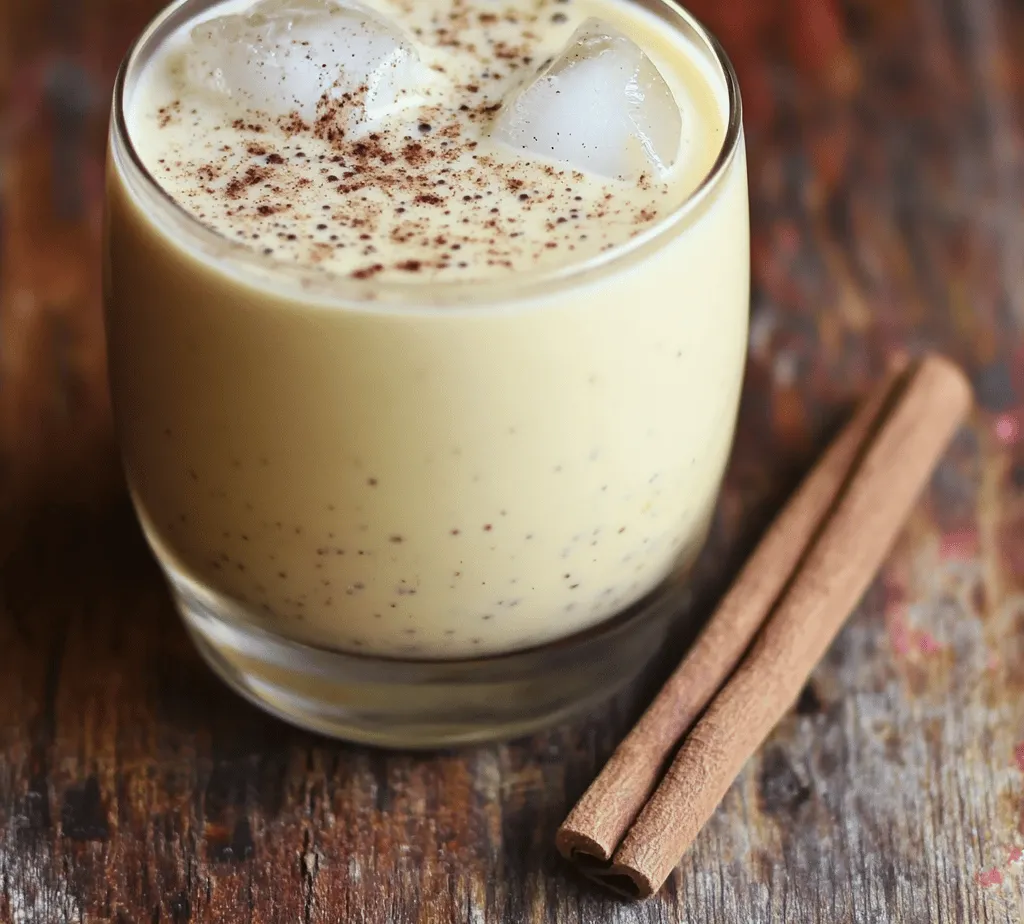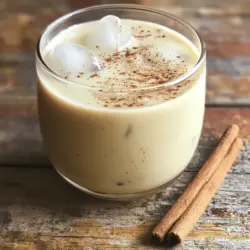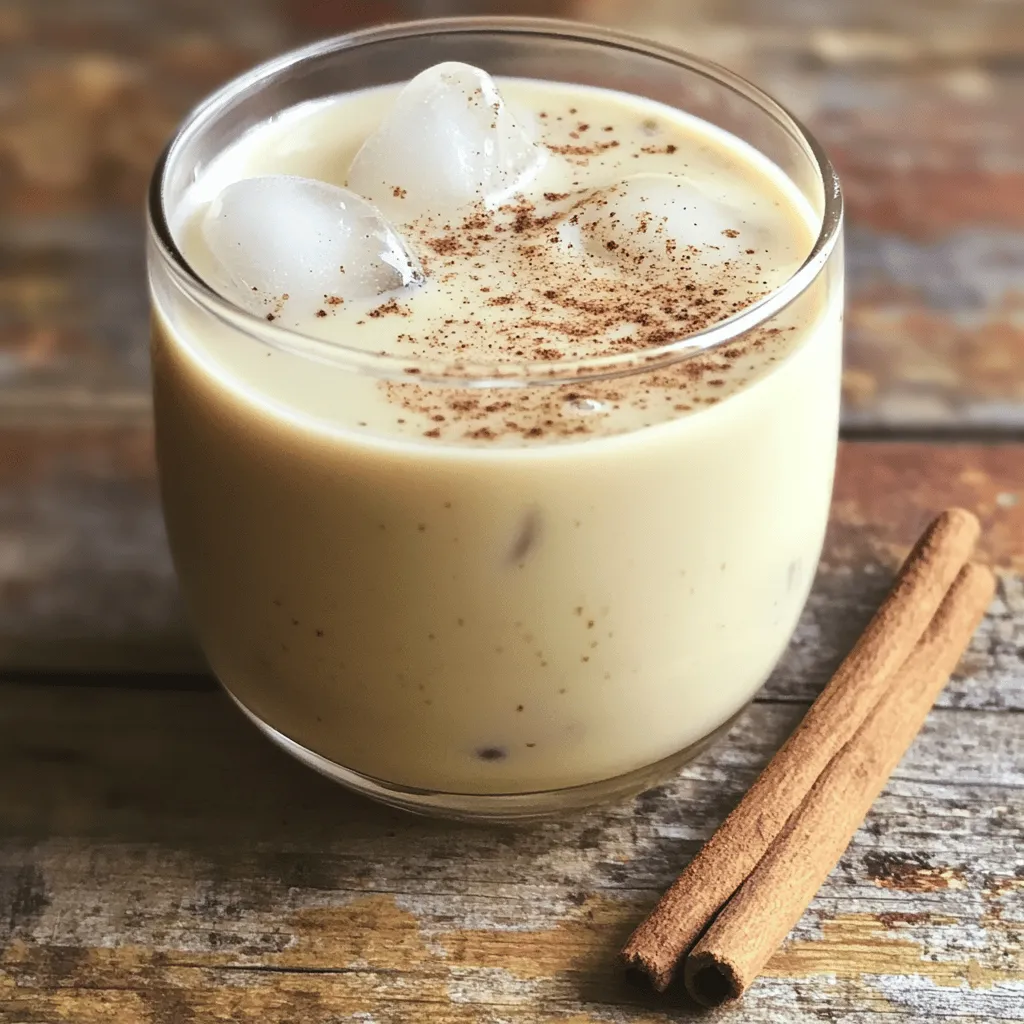Introduction
Horchata, a traditional beverage steeped in history and cultural significance, has captured the hearts and taste buds of many across the globe. Originating from Spain, this drink has evolved into various regional adaptations, with Mexican horchata being a particularly popular variation made primarily from rice, milk, and spices. Its creamy texture and refreshing flavor make horchata a beloved choice, especially during hot summer days or festive gatherings.
In this article, we will explore a unique twist on the classic horchata recipe—Horchata de Café. By incorporating coffee into this cherished drink, we elevate its flavor profile while adding a delightful caffeine kick. This fusion not only enhances the traditional beverage but also broadens its appeal, making it suitable for various occasions, from brunch gatherings to cozy afternoons. Whether you’re a coffee lover or simply a fan of horchata, this recipe will become a staple in your repertoire.
Understanding Horchata
Historical Background of Horchata
The roots of horchata trace back centuries, with its earliest known origins in ancient Egypt, where a beverage made from the tiger nut was consumed. However, the version most recognized today has its roots in Spain, where it is made from a variety of ingredients, including almonds, tiger nuts, and rice. Over time, as the Spanish colonized different regions, horchata adapted to local ingredients and cultures, leading to the creation of distinct variations, particularly in Latin America.
In Mexico, horchata is traditionally made from long-grain white rice, cinnamon, sugar, and milk. It is often served chilled and enjoyed as a refreshing complement to spicy dishes. The drink’s cultural significance is profound; it is often served during celebrations, family gatherings, and everyday meals, symbolizing hospitality and warmth.
Different Variations of Horchata Across Cultures
While Mexican horchata is perhaps the most well-known variant, numerous cultures have their own takes on this beloved beverage. In Spain, horchata is typically made with the chufa, or tiger nut, creating a nutty, slightly sweet flavor. Central American countries also have their interpretations, using ingredients like corn or different spices, showcasing the beverage’s adaptability and regional flavors.
Each version of horchata carries unique stories and traditions, with many families passing down their recipes through generations. This versatility not only highlights horchata’s importance in various cultures but also invites creativity in its preparation, as seen in our Horchata de Café.
The Role of Horchata in Celebrations and Everyday Life
Horchata is more than just a drink; it represents community and shared experiences. In Mexico, it is often enjoyed during significant festivities, like Día de los Muertos or Christmas, where it is served alongside traditional foods. Its creamy sweetness perfectly balances spicier dishes, making it a staple on many dinner tables.
Beyond special occasions, horchata is a beloved beverage for everyday life. Many enjoy it as a refreshing afternoon drink or a soothing companion to breakfast. Its popularity is a testament to its comforting nature and the joy it brings to those who indulge in its smooth, creamy texture.
Ingredients Overview
Detailed Examination of the Key Ingredients
To create the perfect Horchata de Café, it is essential to understand the role of each ingredient in the recipe. Below, we break down the key components that contribute to the drink’s unique flavor and texture.
– Long-Grain White Rice: The foundation of horchata, long-grain white rice, is vital for achieving the drink’s creamy texture. When soaked and blended, the rice releases starches that help create a smooth consistency. Additionally, it imparts a subtle nutty flavor that complements the other ingredients.
– Water: Water is crucial in the soaking process, allowing the rice to soften and release its starches. The amount of water used can be adjusted based on the desired thickness of the final drink.
– Cinnamon Stick: Adding a cinnamon stick infuses a warm, spicy flavor that enhances the overall taste of the horchata. Beyond its flavor profile, cinnamon is known for its health benefits, including anti-inflammatory and antioxidant properties.
– Milk (Dairy or Plant-Based): Incorporating milk into horchata enriches the drink and adds creaminess. For those with dietary restrictions, a variety of plant-based milk options, such as almond, oat, or coconut milk, can be used without compromising the flavor.
– Ground Coffee: The star of our Horchata de Café, ground coffee adds depth and complexity to the drink. The rich, bold flavor of coffee harmonizes beautifully with the sweetness of the horchata, creating a delightful beverage that can be enjoyed at any time of day.
– Sugar: Balancing sweetness is essential in horchata, and sugar plays a key role in this. Depending on your taste preferences, you can adjust the amount of sugar or use alternatives like agave syrup or stevia for a healthier option.
– Vanilla Extract and Salt: A splash of vanilla extract elevates the overall flavor profile, adding a hint of sweetness and warmth. A pinch of salt can enhance the flavors, bringing out the best in each ingredient.
– Suggestions for Ingredient Substitutions and Variations: For those looking to customize their Horchata de Café, there are countless possibilities. For a dairy-free version, opt for almond or coconut milk. If you’re seeking a stronger coffee flavor, consider using espresso or cold brew coffee. Experimenting with different spices, such as nutmeg or cardamom, can also yield exciting variations.
Step-by-Step Instructions
Creating Horchata de Café involves several straightforward steps, each contributing to the drink’s signature taste and texture. Below, we outline the initial steps to guide you through the preparation process.
Rinsing the Rice
The first step in making Horchata de Café is rinsing the long-grain white rice. This process is essential for removing excess starch, which can lead to a gritty texture in the final drink. To rinse the rice, place it in a fine-mesh strainer and run it under cold water until the water runs clear. This typically takes a few minutes, but it is a crucial step to achieve a smooth consistency.
Blending the Rice and Water
Once the rice is rinsed, it’s time to blend it with water. In a blender, combine the rinsed rice with an appropriate amount of water. For a standard recipe, use about 1 cup of rice to 4 cups of water. Blend on high speed until the mixture is well combined. The goal is to break down the rice into a fine consistency, which will help release the starches that contribute to the drink’s creaminess.
Soaking the Mixture
After blending, pour the rice-water mixture into a large bowl or pitcher. Cover it and let it soak at room temperature for at least 3 hours or overnight if possible. Soaking allows the rice to soften further, enhancing the texture of the horchata and maximizing the flavor extraction.
In the next part of this article, we will continue with the detailed instructions for completing the Horchata de Café, including how to strain the mixture, incorporate the remaining ingredients, and serve this delightful beverage. Stay tuned to discover the remaining steps and tips for achieving the perfect creamy coffee horchata!

Soaking Time: Why Allowing Flavors to Meld is Crucial
The process of making Horchata de Café begins with soaking the rice and nuts, which is critical for developing the drink’s rich and nuanced flavor. Allowing the ingredients to soak for at least four hours, or preferably overnight, enables the rice and nuts to soften and release their natural flavors into the water. This soaking process not only enhances the overall taste but also helps to achieve a smoother texture when blended.
When the rice absorbs the water, it becomes plump and tender, which is essential for creating the creamy consistency that characterizes a good horchata. The nuts, typically almonds or cashews, contribute a subtle nuttiness that balances beautifully with the sweetness from the sugar and the spice from the cinnamon. By giving these ingredients ample time to infuse the liquid, you set the stage for a delightful beverage that will impress any palate.
Straining the Mixture: Methods for Achieving a Smooth Texture
After soaking, the next step is to strain the mixture to achieve that velvety texture that horchata de café is known for. There are a few methods to effectively strain the mixture:
1. Using a Fine Mesh Sieve: Place a fine mesh sieve over a large bowl and pour the soaked mixture through it. Use a spatula or the back of a spoon to press down on the solids, extracting as much liquid as possible.
2. Cheesecloth Method: For a finer strain, line a bowl with cheesecloth and pour the mixture into it. Gather the corners of the cheesecloth and twist to squeeze out the liquid. This method ensures that you get a silky smooth drink without any graininess.
3. Nut Milk Bag: If you have a nut milk bag, this is an excellent option for straining horchata. Simply pour the mixture into the bag, seal it, and squeeze out the liquid. This method is efficient and yields very little waste.
It’s essential to take your time with this step, as a thorough strain will make a significant difference in the final product. Any leftover solids can be repurposed in smoothies or baked goods to avoid waste.
Brewing the Coffee: Techniques for Optimal Flavor Extraction
To achieve the perfect balance in your horchata de café, brewing the coffee correctly is paramount. Start with high-quality coffee beans, as the flavor of the coffee will shine through. Here are some techniques to consider:
1. Cold Brew: For a smooth and less acidic flavor profile, consider using the cold brew method. Combine coarsely ground coffee with cold water and let it steep for 12-24 hours in the refrigerator. This method extracts flavors gently, resulting in a rich and mellow coffee infusion.
2. Hot Brew: If you prefer a more traditional approach, brew your coffee using your favorite method—whether it be a drip coffee maker, French press, or pour-over. Use a slightly stronger coffee ratio than usual to ensure that the coffee flavor stands out against the creaminess of the horchata.
3. Espresso: For a stronger kick, try using espresso. Brew a shot or two and let it cool before combining it with the horchata mixture. The concentrated flavor of espresso can elevate the drink to a new level.
Regardless of the brewing method chosen, allow the coffee to cool to room temperature before mixing it with the horchata base to prevent the drink from heating up and losing its refreshing quality.
Combining Ingredients: Ensuring Even Sweetness and Flavor
Once you have strained the horchata base and brewed the coffee, it’s time to combine these elements. In a large pitcher, mix the strained horchata with the cooled coffee. The key here is to taste as you go, adjusting the sweetness and spice level to your preference.
– Sweetening: Start with a few tablespoons of sugar, stirring until fully dissolved. Depending on your taste, you can also explore alternatives like agave syrup, honey, or even a sugar substitute for a healthier option.
– Spicing: Add ground cinnamon to enhance the flavor. A pinch can elevate the drink, but be careful not to overpower it. You can also add a splash of vanilla extract for an additional depth of flavor.
Once combined, stir gently to ensure even distribution of sweetness and spices throughout the mixture.
Chilling the Drink: The Significance of Serving it Cold
Horchata de café is best served chilled, making it an ideal refreshment for warm days. After combining your ingredients, refrigerate the drink for at least an hour or serve it immediately over ice. The chilling process allows the flavors to meld further and enhances the drink’s refreshing qualities.
For serving, fill glasses with ice cubes to keep the horchata de café cold. The contrast of the cold beverage with the warmth of the spices creates an inviting experience for anyone enjoying this drink.
The Flavor Profile of Horchata de Café
Horchata de café is a delightful fusion of flavors, characterized by its creamy texture and aromatic spices. The base of this drink offers a subtle sweetness, complemented by the rich, roasted notes of the coffee. The rice contributes a soothing creaminess, while the nuts add a light, nutty undertone that enhances the drink’s overall complexity.
When tasting horchata de café, you’ll likely notice the balanced interplay of flavors. The sweetness from the sugar harmonizes with the warmth of the cinnamon, creating a comforting sensation. This drink has a lovely mouthfeel, creamy yet refreshing, making it perfect for sipping.
Suggestions for Garnishing
To elevate the presentation and flavor of your horchata de café, consider garnishing with:
– Ground Cinnamon: A sprinkle on top adds a touch of warmth and enhances the visual appeal.
– Cacao Nibs: For a chocolatey twist, sprinkle some cacao nibs for added texture and flavor.
– Whipped Cream: Top with a dollop of whipped cream for an indulgent treat, especially when serving at special occasions.
Serving Suggestions
Horchata de café is versatile and can be enjoyed in various settings:
– Brunch: Serve it alongside breakfast dishes like pancakes, waffles, or huevos rancheros for a delightful start to the day.
– Parties: This drink can be a refreshing option for gatherings or summer parties, providing a non-alcoholic alternative.
– Hot Days: Perfect as a cooling drink during hot weather, horchata de café is ideal for picnics or outdoor events.
Pairing Ideas with Foods
To complement the flavors of horchata de café, consider pairing it with:
– Spicy Dishes: The sweetness and creaminess balance well with spicy Mexican or Latin dishes, such as tacos or enchiladas.
– Desserts: Serve alongside sweet treats like churros, flan, or tres leches cake, where the smoothness of the drink complements the dessert’s richness.
– Savory Snacks: Pair with light snacks like tortilla chips and guacamole for a refreshing counterbalance.
Creative Serving Ideas
Beyond the traditional serving, horchata de café can be used in creative ways:
– Cocktails: Use it as a base for cocktails, mixing it with spirits like rum or whiskey for a unique twist on a classic beverage.
– Desserts: Incorporate it into desserts like puddings or ice creams, adding a flavorful element to your creations.
Nutritional Benefits of Horchata de Café
Horchata de café comes with a range of nutritional benefits derived from its key ingredients:
– Rice: Provides carbohydrates for energy, while also being gluten-free.
– Nuts: A source of healthy fats, protein, and fiber, contributing to heart health and satiety.
– Cinnamon: Known for its anti-inflammatory properties, cinnamon can help regulate blood sugar levels and adds a delightful flavor.
– Coffee: Offers antioxidants that can improve mental alertness and metabolism.
If you’re looking to make a healthier version of horchata de café, consider reducing the sugar content or substituting it with natural sweeteners. You could also experiment with almond milk or coconut milk instead of traditional dairy, making it lactose-free and suitable for vegan diets.
Conclusion
Horchata de café is not just a beverage; it’s a celebration of flavors and traditions. This creamy, refreshing drink brings together the best of both worlds, combining the soothing qualities of horchata with the invigorating notes of coffee. Whether enjoyed during brunch, at a summer gathering, or as a dessert pairing, horchata de café is sure to delight.
As you explore this recipe, consider making it your own by experimenting with various spices, sweeteners, and serving styles. Embrace the cultural roots of horchata while adding your personal touch, and enjoy the delightful experience this drink offers. Whether you’re sipping it alone or sharing it with friends, horchata de café is a delightful way to connect with culinary traditions and create new memories.



